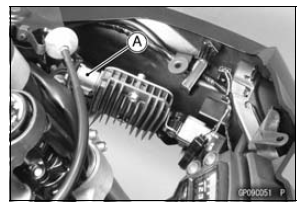

There are three types of alternator failures: short, open (wire burned out), or loss in rotor magnetism. A short or open in one of the coil wires will result in either a low output, or no output at all. A loss in rotor magnetism, which may be caused by dropping or hitting the alternator, by leaving it near an electromagnetic field, or just by aging, will result in low output.
Turn the ignition switch to OFF.
Remove the left upper inner fairing (see Upper Inner Fairing Removal in the Frame chapter).
Disconnect the alternator lead connector [A].
Connect the hand tester as shown in the table 1.

Special Tool - Hand Tester: 57001-1394
Start the engine.
Run it at the rpm given in the table 1.
Note the voltage readings (total 3 measurements).
Table 1 Alternator Output Voltage at 4 000 r/min (rpm)

If the output voltage shows the value in the table, the alternator operates properly. The regulator/rectifier is damaged.
If the output voltage shows a much lower reading than that given in the table, stop the engine and inspect the stator coil resistance.
Stop the engine.
Connect the hand tester as shown in the table 2.
Special Tool - Hand Tester: 57001-1394
Table 2 Stator Coil Resistance at 20┬░C (68┬░F)
If there is more resistance than shown in the table, or no hand tester reading (infinity) for any two leads, the stator has an open lead and must be replaced. Much less than this resistance means the stator is shorted, and must be replaced.
Any hand tester reading less than infinity (∞) indicates a short, necessitating stator replacement.
If the stator coil has normal resistance, but the voltage check showed the alternator to be defective; then the rotor magnets have probably weakened, and the rotor must be replaced.
 Charging Voltage Inspection
Charging Voltage Inspection Regulator/Rectifier Inspection
Regulator/Rectifier InspectionIC Igniter Inspection
The IC igniter is built in the ECU [A].
Refer to the following items.
Interlock Operation Inspection (see Interlock Operation
Inspection)
Ignition System Troubleshooting (see Ignition System
section)
ECU Power Supply Inspection (see ECU Power Supply
Inspection in the Fuel System (D ...
Connecting Rod Twist Inspection
With the big-end arbor [A] still on V block [C], hold the
connecting rod horizontally and measure the amount that
the arbor [B] varies from being paralleled with the surface
plate over a 100 mm (3.94 in.) length of the arbor to determine
the amount of connecting rod twist.
If the conne ...
Upper Fairing Assembly Removal
Remove:
Lower Fairings (see Lower Fairing Removal)
Center Inner Fairing (see Center Inner Fairing Removal)
Upper Inner Fairings (see Upper Inner Fairing Removal)
Windshield (see Windshield Removal)
Disconnect the front turn signal light lead connector [A]
(both sides).
Remove the bo ...